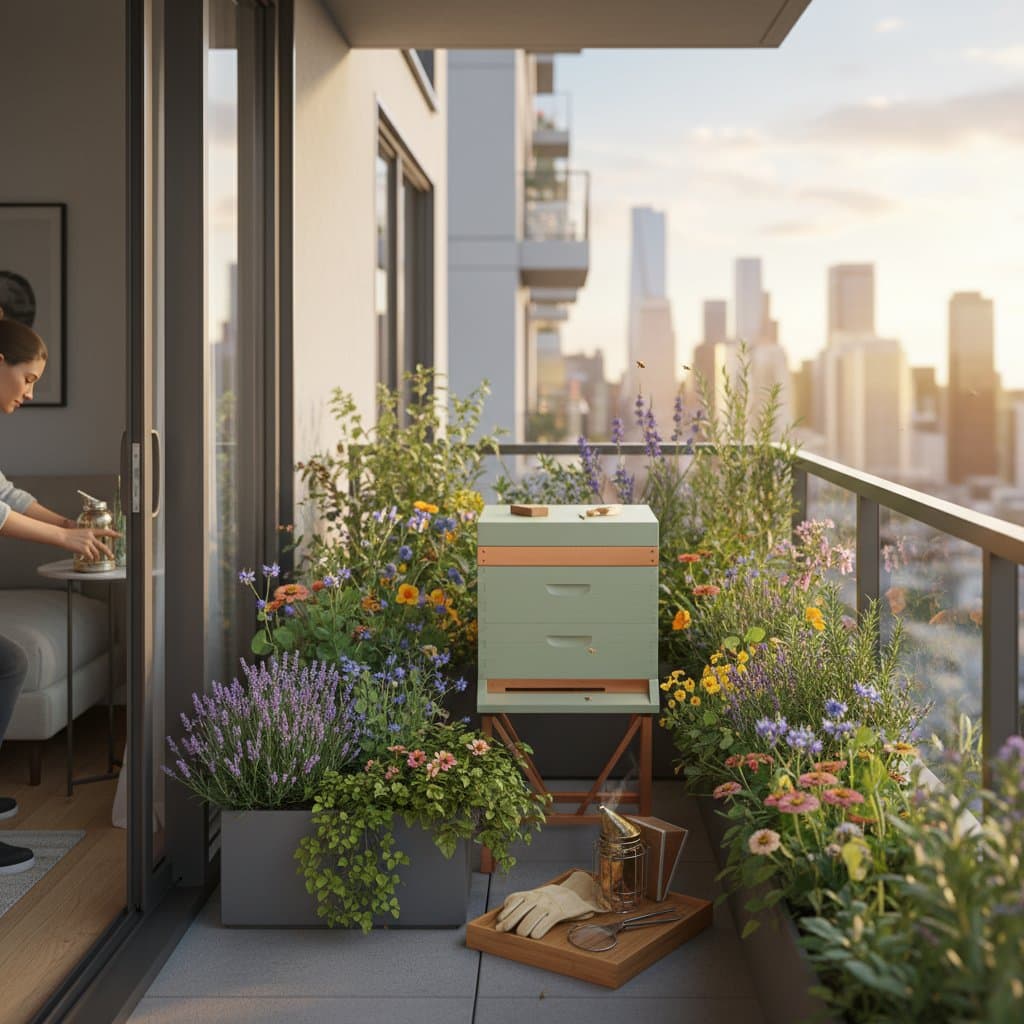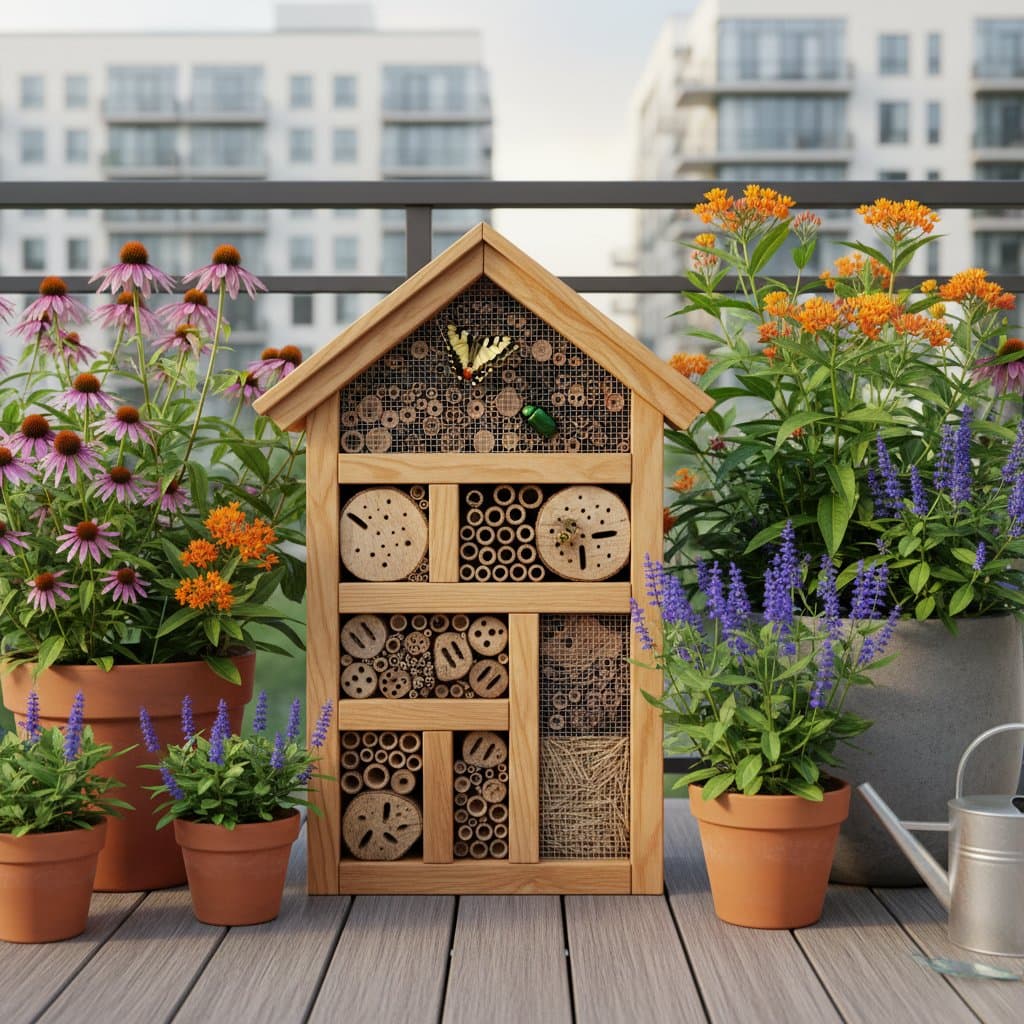Start a Balcony Hive With One Small Box and Basic Gear
Balcony Bees: An Urban Trend Buzzing in 2025 Cities
Balconies in urban settings offer untapped potential beyond potted plants and seating. In cities worldwide, residents increasingly convert these compact spaces into thriving habitats for bees. Balcony beekeeping fosters pollinators, enhances nearby gardens, and allows individuals to contribute directly to environmental stewardship. Individuals require no vast land or extensive prior knowledge to embark on this practice. A thoughtful plan, adherence to safety protocols, and consistent monitoring suffice to launch successfully.
This guide delineates the essentials of balcony beekeeping, outlines secure initiation methods, and provides strategies to maintain harmony with bees and neighboring residents.
Overview of Balcony Beekeeping
Balcony beekeeping involves maintaining one or two compact hives on a balcony, rooftop, or terrace. The primary objective centers on establishing a pollinator-supportive environment amid densely populated areas. Bees facilitate pollination for surrounding herbs, flowers, and fruit-bearing plants. These insects forage within a radius of up to three miles, meaning a single hive can positively affect numerous urban gardens.
The surge in urban beekeeping stems from a desire for intimate connections with nature and access to locally produced honey. A balcony hive occupies minimal space, comparable to a standard recycling bin, while delivering substantial benefits to pollinator populations. Success hinges on crafting a secure, enclosed system that aligns with building constraints and personal routines. Consider factors such as sunlight exposure, wind patterns, and accessibility when planning the setup.
Essential Tools and Materials
Commence with straightforward, reliable equipment. Opt for new items to minimize risks of disease transmission, which can occur with secondhand gear. Begin modestly with a single hive of moderate dimensions to build confidence.
Core components for the setup include:
- A Langstroth or top-bar hive, measuring approximately 16 to 20 inches in height
- A full protective suit paired with durable gloves
- A smoker and a sturdy hive tool for inspections
- A soft bee brush for gentle handling
- A feeder designed for sugar water supplementation
- A healthy bee colony sourced from a certified local supplier
Additional items for enhanced comfort:
- A lightweight stool for prolonged tasks
- A water sprayer to moderate hive temperature
- A compact storage bin dedicated to tools
Allocate roughly five square feet of balcony surface area. Verify that the railing or floor can bear the hive's weight, which may approach 80 pounds when laden with honey. Secure the location against tipping or excessive movement from wind.
Step-by-Step Installation Guide
1. Verify Local Regulations
Prior to acquiring bees, research municipal beekeeping ordinances thoroughly. Certain jurisdictions mandate notifications, permits, or liability insurance. Consult the property manager regarding balcony load capacities and policies on shared spaces. Document approvals in writing to avoid future disputes.
2. Select Optimal Hive Placement
Position the hive in a corner receiving morning sunlight and partial afternoon shade. Bees thrive in moderate warmth to sustain activity levels, yet excessive heat can stress the colony. Orient the entrance toward unobstructed airspace, steering clear of neighboring windows, doors, or high-traffic paths. This arrangement minimizes bee flights over communal areas.
3. Prepare the Foundation
Elevate the hive on a stable stand raised 12 inches from the surface to promote ventilation and deter moisture accumulation. Affix rubber pads beneath the legs to dampen vibrations from balcony activity or urban noise. Ensure the stand remains level to prevent frame misalignment inside the hive.
4. Introduce the Bee Colony
Don the complete protective ensemble before proceeding. Transfer the bees by gently shaking them into the hive body, then secure the queen cage within. Seal the lid promptly to contain the colony. Prepare a sugar water solution at a 1:1 ratio for initial feeding, replenishing as needed during the acclimation period of the first week.
5. Conduct Routine Monitoring
Inspect the hive weekly by lifting the lid to assess food stores, brood development, and available space. Employ the smoker sparingly to pacify the bees without overwhelming them. Observe for indicators of overcrowding, such as tightly packed frames or emerging queen cells; respond by adding a super box or considering a colony split to manage growth.
6. Harvest Honey Responsibly
Defer honey extraction until the conclusion of the inaugural season, allowing the colony to establish fully. Reserve at least 40 pounds of honey for the bees' winter sustenance. Employ a manual extractor for small yields, or collaborate with a local beekeeping association to access communal equipment. Process frames carefully to avoid damaging wax structures.
Essential Safety Protocols
Bees exhibit docility when left undisturbed, yet vigilance remains paramount. Integrate these practices into every interaction with the hive.
- Don full protective attire for all inspections, as even temperate bees may protect their home.
- Refrain from applying strong fragrances, such as perfumes or hairsprays, prior to handling the hive.
- Provide a shallow water tray filled with pebbles nearby; bees utilize it for drinking, reducing intrusions into adjacent water sources.
- Inform proximate residents in advance of installation through brief, informative discussions to foster goodwill.
- In the event of a sting, extract the stinger using a fingernail edge, cleanse the area with soap and water, and apply ice to alleviate swelling.
For households or neighbors with allergies, maintain an epinephrine auto-injector in an accessible location and communicate its availability clearly.
Common Troubleshooting Scenarios
Compact hives encounter typical urban challenges. Vigilant observation enables prompt resolutions.
Issue: Bees appear lethargic or inactive.
Potential causes: Inadequate nutrition or parasitic infestations.
**Resolution: Install a supplemental sugar-water feeder and perform a mite detection test using a sticky board placed beneath the brood frames for 24 hours.
Issue: Heightened aggression from the colony.
Potential causes: Adverse weather, queen absence, or environmental disturbances.
**Resolution: Conduct a thorough queen inspection and mitigate balcony vibrations or noises. If aggression persists beyond two weeks, introduce a new queen to restore colony equilibrium.
Issue: Intrusion by ants or wasps.
**Resolution: Coat the stand legs with a narrow band of petroleum jelly to create a barrier. Store all sugary beverages in sealed containers to avoid attracting additional pests.
Initial Investment and Time Commitment
Establishing a balcony hive in the first year typically incurs expenses ranging from $250 to $400. Primary outlays cover the bee package, hive components, and safety apparel. Dedicate approximately two hours weekly to inspections, feeding, and documentation. Rewards manifest as multiple jars of fresh honey and observable improvements in local vegetation vitality.
Affiliate with a regional beekeeping society to economize; these groups often loan extractors and offer gratis guidance from seasoned members.
Ongoing Maintenance Practices
Sanitize hive tools post-inspection using warm water and mild soap, ensuring thorough drying to prevent mold. Renew comb frames biennially to curb pathogen accumulation. During winter, wrap the hive in straw bales or foam insulation while narrowing the entrance to conserve heat. In spring, dismantle insulation promptly to accommodate colony expansion.
Seasonal Care Guidelines
Spring preparations: Evaluate honey reserves and substitute any compromised frames. Supply sugar water until natural nectar sources proliferate.
Summer management: Monitor for swarming risks amid rapid population increases. Install an additional box to provide expansion room as needed.
Fall adjustments: Ensure sufficient honey stores remain and constrict the entrance to deter predatory wasps.
Winter oversight: Restrict hive openings to mild-weather days. Ausculate for humming sounds to verify ongoing activity within.
Seeking Professional Assistance
Engage a qualified beekeeper when encountering severe issues, such as widespread dead brood, unrelenting mite populations, or complaints from neighbors about bee congregations on common surfaces. Professionals perform detailed diagnostics, apply targeted treatments, and advise on hive relocation if necessary. Inquire about their methodologies and any implications for surrounding flora.
Realizing Urban Pollination Benefits
Balcony beekeeping extends beyond personal honey production to cultivate resilient city ecosystems. Each hive bolsters biodiversity, aids food security through enhanced pollination, and instills a profound sense of environmental agency. As urban spaces evolve, these small-scale efforts amplify collective impact, proving that dedicated individuals can nurture nature amid concrete landscapes.



